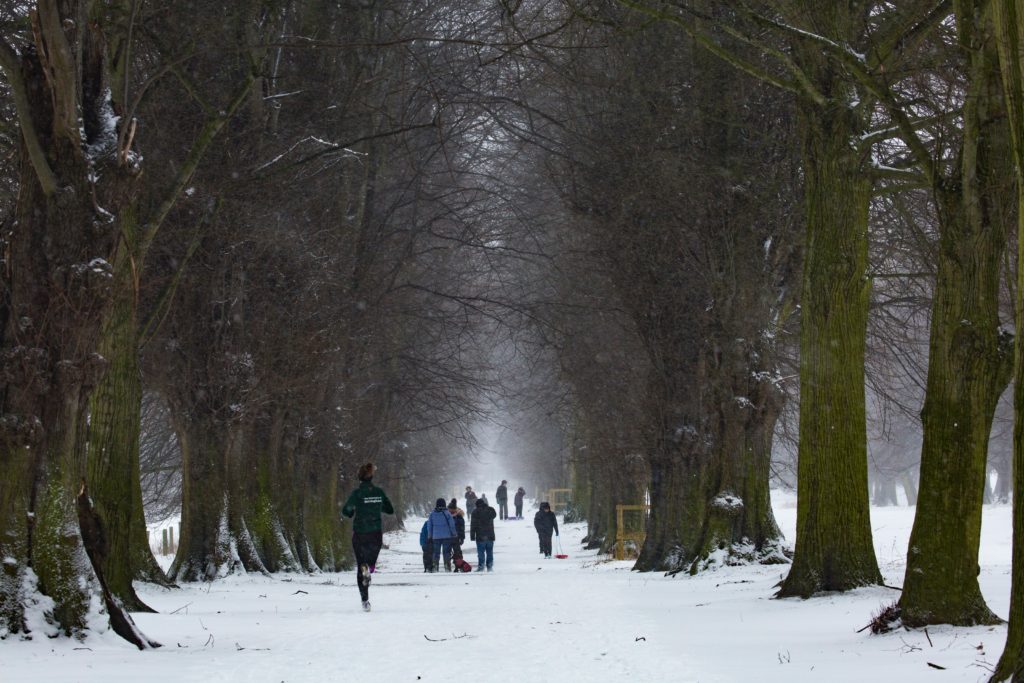Do Your Fueling Needs Change During Winter?

This winter, you may have asked yourself “how do my fueling needs change during the winter?” Here’s an overview of what you need to know about wintertime fueling throughout the day and during your long workouts.
Every Day Fueling
- The amount of energy your body uses during exercise in the cold is higher than the amount of energy your body uses during exercise in warm or neutral temperatures. The reason for this is because your body is working harder to maintain your core temperature in cold environments than in warm ones. The exact increase in energy needed will depend on how well you dress for the weather & how acclimated you are to the temperatures in general. Likely, this isn’t something you need to overthink, but if you do notice you feel more hungry than usual while training or competing in colder temperatures, you can certainly trust those cues.
- Vitamin D is an important nutrient for endurance athletes. Adequate levels of vitamin D will improve your immunity, bone strength, levels of inflammation, and ability to recover from injury. One of the main ways we absorb vitamin D is through direct sunlight exposure; something that can be hard to come by during the winter months. If you’re an athlete that typically gets your daily vitamin D exposure by running in the sun, you may experience a decrease in your blood levels of vitamin D during the wintertime without noticing it at first. Adding foods such as eggs (particularly the yolk), salmon, tuna, milks fortified with vitamin D, and fortified cereals will help improve your overall vitamin D intake.
- For many athletes, the winter is a time for a bit of an off-season. Your weekly volume of exercise may be lower than usual and the intensity of your runs is likely lessened. If this resonates with you, here are a few tips for off-season fueling.
- Trust your hunger & respect your fullness. Even though you aren’t exercising as much as usual, you still have energy needs that need to be met. You may notice you aren’t as hungry as you are during your peak weeks of training, and that’s alright. Choose portion sizes that feel good and comfortable in your body.
- Adjust the focus of the food on your plate. During your most intense weeks of training, your plate should be largely full of hearty carbohydrate-rich foods like bread, pasta, potatoes, etc. During your off-season, alter that portion to include more fiber-rich vegetables and fruits. Your protein shouldn’t skyrocket higher than usual unless you are doing a large bulk of weight lifting at this time.
- As always, enjoy an “all foods fit” mentality with your food options. If there are particular foods you love, but cannot have as often during your main training period due to GI distress, now is a good time to enjoy them. You will not have to worry about how you’ll feel in your workout the next day.
During Workout Fueling
While wintertime may be an off-season for some, others train right through it! Anyone with a late winter or early spring race coming up knows just what I’m talking about. Fueling during a long workout in the winter is largely the same as any other time of the year, but there are few things to note as you pack your food & water with you:
- Even though it may be tempting to leave your bottles & hydration vests at home in colder weather, your body still needs additional fluid during long efforts. Thirst sensations are blunted in cold vs. warm temperatures. This can lead you to think you can get away with less than what you truly need. In reality, the difference between fluid needs in cold weather running vs. warm weather running are only about 3 oz less per hour. This same principle will apply to electrolyte needs as well. While you may not need as much as during thesummer months, you still need to be conscious that you are getting enough. If you are curious about additional details regarding winter hydration, check out this article.
- Stick to the higher range of carbohydrate intake per hour of activity. If you normally aim for 50-60 grams of carbohydrate per hour of activity, plan for 60. Since your body is using more energy to maintain your core temperature & sustain you during your workout/race, a little extra fuel is only going to help you. Don’t forget that muscle and liver glycogen is the main source of fuel your body. This is what your body relies on when shivering and warming up in very cold conditions. Here’s a guide of ideal carbohydrate recommendations for you to work up to:
- 1-2 hrs: 30-60 grams/carbohydrate per hour.
- 2-4 hrs: 60-90 grams/carbohydrate per hour.
- 5 hrs+: 90-120 grams/carbohydrate per hour. At this point, you may also consider taking a calorie-based approach instead of a carbohydrate-only approach.
Conclusion
Do your fueling needs change during the winter? Training through cold temperatures can be difficult, applying these nutritional principles will make winter training more doable. Also, don’t forget that beyond nutrition, wearing the right clothing will help.
Trust your hunger cues throughout the winter, whether you are training hard or taking a bit of a break. If training, your body is working harder in those cold temperatures to keep you safe, warm, & moving than it does in warmer climates. If you are taking a break, don’t forget that your body still needs fuel. This fuel will help you to breathe, think, and perform any other activity you are participating in.
Be conscious of your vitamin D intake & consider incorporating 1-2 more vitamin-D rich foods into your regular food routine. During long runs or workouts, continue to be diligent with fluid & electrolyte intake, even though you may feel less of a need for these components. Aim for a higher intake of carbohydrate per hour to adjust for increased energy & carbohydrate used during exercise in the cold.
References
- Nanna L. Meyer, Melinda M. Manore & Christine Helle (2011) Nutrition for winter sports, Journal of Sports Sciences,29:sup1, S127-S136, DOI: 10.1080/02640414.2011.574721
- Charlot K, Faure C, Antoine-Jonville S. Influence of Hot and Cold Environments on the Regulation of Energy Balance Following a Single Exercise Session: A Mini-Review. Nutrients. 2017 Jun 10;9(6):592. doi: 10.3390/nu9060592. PMID: 28604591; PMCID: PMC5490571.
- de la Puente Yagüe M, Collado Yurrita L, Ciudad Cabañas MJ, Cuadrado Cenzual MA. Role of Vitamin D in Athletes and Their Performance: Current Concepts and New Trends. Nutrients. 2020 Feb 23;12(2):579. doi: 10.3390/nu12020579. PMID: 32102188; PMCID: PMC7071499.
Institute of Medicine. 1996. Nutritional Needs in Cold and High-Altitude Environments: Applications for Military Personnel in Field Operations: Chapter 10: Muscle Metabolism and Shivering During Cold Stress (pg 181-186). Washington, DC: The National Academies Press. https://doi.org/10.17226/5197.

Jackie Hendrickson RD, MPH is a registered dietitian with a Masters Degree in public health nutrition from Utah State University. Jackie is the owner of Enduura Nutrition and loves coaching her athletes to their athletic potential through sustainable training & nutrition principles. She is an avid road & trail marathoner with a background in collegiate track, cross country, and competitive swimming. Jackie and her husband, Adam, were teammates in college and continue to pursue their running goals together. They live in beautiful Ogden, Utah with their 2 year old son, Lincoln.







